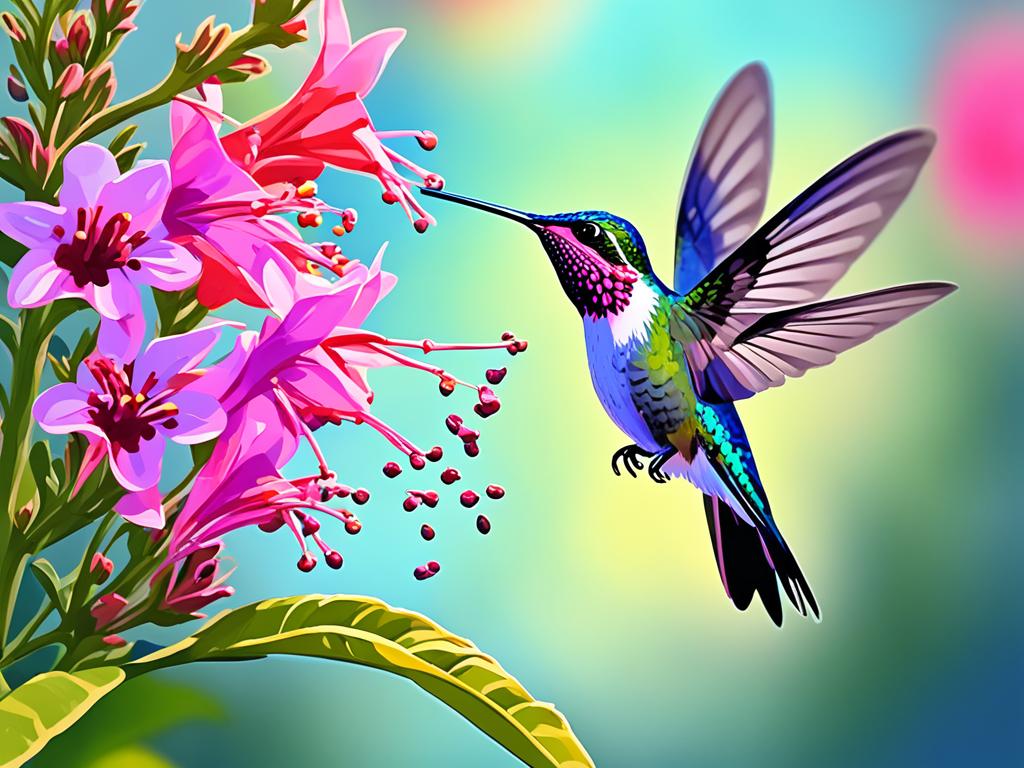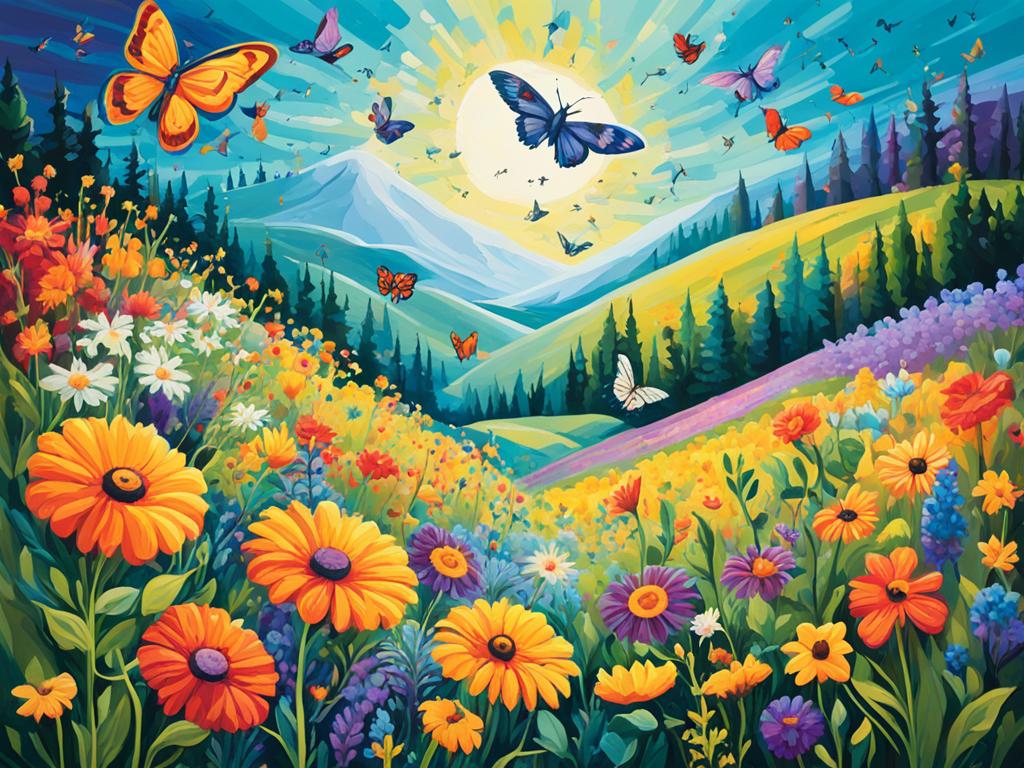Animals are key to pollination and spreading seeds. This is vital for many plants to reproduce. Understanding how animals help with these processes is critical. It keeps ecosystems healthy and full of life. By spreading seeds, animals ensure plants can grow and spread in different places.
Key Takeaways
- Animal pollination and seed dispersal are vital processes for plant reproduction.
- These natural processes contribute significantly to ecosystem health and biodiversity.
- Understanding animal vectors in seed dispersal helps maintain the balance of natural habitats.
- Animals act as key partners in spreading plant progeny across various environments.
- Conserving animal pollinators ensures the stability and sustainability of ecosystems.
The Importance of Animal Pollinators
Animal pollinators are key to healthy ecosystems everywhere. Creatures like bees, butterflies, birds, and bats are vital. They help many plants produce seeds and fruits. Recognizing the importance of animal pollinators helps keep biodiversity. It also ensures farming can last.
Ecological Contributions
These pollinators are crucial for diverse environments. They aid the breeding of various plants. This keeps plant genetics varied, which is important.
This variety helps ecosystems handle changes and stress better. Benefits from pollination help make homes for many organisms. This ranges from insects to big mammals.
Economic Benefits
Animal pollinators also impact the economy greatly. They are essential in farming for good crop yields and quality. This leads to more production of key foods.
These foods feed both people and animals. The economic benefit from pollination is huge. It helps farmers and feeds the world.
Ecosystem Stability
Pollinators keep ecosystems stable and strong. Their work connects with many other natural processes. This keeps life on Earth going.
By helping plants reproduce, pollinators build ecosystems. This benefits a wide range of life, including humans. Recognizing their importance of animal pollinators shows the value of nature’s links.
Pollinators are critical for nature’s balance and our economy. Addressing their struggles is key for both environment and society.
Types of Animal Pollinators
Many different animals help plants to fertilize by being pollinators. This group includes insects, birds, and mammals. Each one has a special way to help plants.
Insects like bees, butterflies, and moths lead the pollination process. Bees are known for their effective work. Butterflies and moths travel long distances, moving pollen as they go.
Homingbirds play a big part among bird pollinators. They are crucial in tropical areas. Their long beaks let them get pollen from deep inside flowers.
When thinking of pollinators, mammals might not come first in mind. Yet, bats do a lot of work in this field. In tropical and desert places, they pollinate at night. This helps many plants to reproduce.
| Type | Key Species | Unique Pollinating Behavior |
|---|---|---|
| Insects | Bees, Butterflies, Moths | High mobility, attracted to bright flowers |
| Birds | Hummingbirds | Long beaks, effective in tropical regions |
| Mammals | Bats | Night pollination, support desert ecosystems |
Diverse pollinators form a complex network in nature. They have developed special techniques that help various plants reproduce. This ensures the health of plants and ecosystems.
How Animals Assist in Seed Dispersal
Animals help spread plant seeds to new areas. This is key for plant growth and diversity.
Methods of Seed Dispersal
Animals use different ways to move seeds. Endozoochory is when they eat fruits and pass the seeds elsewhere. Epizoochory is seeds sticking to animals and getting carried to new places. Diplochory mixes these methods for better seed travel.

Examples of Seed Dispersal by Animals
Birds eat berries and then spread the seeds. This helps plants like the mistletoe. Squirrels also play a role by burying seeds, which helps them grow.
Bats help by moving seeds far from the parent plant. These actions show how animals and plants rely on each other. They help plant species thrive in new areas.
Animal-Pollinated Plant Species
Animal-pollinated plants are essential to many ecosystems. They depend on animals to help them reproduce. This partnership benefits both parties.
Common Plant Species
Some plants need animals to pollinate them. Flowers like sunflowers, tulips, and lavender depend on this. Insects, birds, or mammals carry pollen from one flower to another.
This process helps plants make seeds. It keeps plant populations going. This relationship is key to the health of many ecosystems.
Unique Plant-Animal Relationships
Some plant and animal relationships are truly unique. Take the fig tree and the fig wasp, for example. The wasp pollinates the tree while also laying its eggs.
This special cooperation helps both species survive. Orchids also have unique partners, like certain bees. These bees are essential for the orchids’ reproduction.
Mutualism Between Animals and Plants
Animals and plants help each other in mutual benefits in pollination. They make sure both sides grow well. Bees, butterflies, and birds move pollen from one flower to another. This helps plants make seeds.
In these symbiotic relationships in nature, animals find food. At the same time, plants get to spread their genes. This cooperation helps many plant kinds to grow. It keeps the earth in balance.
Animals also spread seeds through eating and then moving them. This way, plants can grow in new places. It shows how pollination and seed spreading are good for all. It helps many life forms and their homes stay healthy.
Examples of Key Animal Pollinators
Animal pollinators come in many forms, each with a distinct role. They help many plant species reproduce. This includes insects, birds, and mammals, all contributing in different ways.
Insects
Bees are the most known insect pollinators. They pollinate crops like almonds, apples, and blueberries. Butterflies also play a crucial role, especially for plants with tubular flowers. Besides them, flies, beetles, and ants are key pollinators, each having their own special roles.
Birds
In the tropics, birds are important pollinators. Hummingbirds can hover, reaching flowers others can’t. Sunbirds and honeyeaters help pollinate a wide range of plants.
Mammals
Mammals too are vital, though often forgotten. Night-active bats pollinate nocturnal flowers, big and smelling sweet. Primates, though small, help by carrying pollen on their fur between plants.
| Animal Group | Key Pollinators | Plant Examples |
|---|---|---|
| Insects | Bees, Butterflies | Apples, Blueberries |
| Birds | Hummingbirds, Sunbirds | Theobroma cacao (cacao), Heliconia |
| Mammals | Bats, Primates | Bananas, Mangoes |
The Role of Animals in Pollination and Seed Dispersal
Animals play a crucial role in pollination, promoting ecological health and biodiversity. They participate in spreading seeds. This activity helps continue the life cycle of plants.
Many animals help move pollen from one flower to another. This lets plants make seeds and fruits. It feeds various species and keeps the ecosystem alive. Bees, butterflies, and birds are key to this process. They highlight the significance of animal role in pollination.
Animals are also central to seed dispersal, a key ecological action. They spread seeds through eating and moving them, or by caching. This spreading helps plants grow strong and diverse, balancing the ecosystem.
The following table outlines some common pollinators and the plants they assist:
| Animal | Common Pollinated Plants |
|---|---|
| Bee | Apple, Almond, Blueberry |
| Butterfly | Milkweed, Marigold, Dahlia |
| Bird | Hibiscus, Fuchsia, Trumpet Vine |
| Bat | Banana, Mango, Avocado |
Understanding the significance of animal role in pollination is key. It shows why we must protect these animal helpers. Their work supports plant life and broader ecological systems.
Diversity of Animal Pollinators
The variety of animal pollinators boosts healthy, diverse ecosystems. The importance of animal pollinator diversity is huge. It makes pollination processes better and more successful. The different places pollinators live show how regional pollinator species adapt. This helps the ecosystems they are part of.
Regional Variations
Different parts of the world have unique pollinators. For example, bats are key pollinators in the tropics for fruits. In cooler places, bees are the main pollinators. These differences show how adaptable animal pollinators are. They also show why it’s important to understand local ecosystems.
Impact of Biodiversity on Pollination
Biodiversity greatly affects pollination dynamics. More biodiversity means stronger ecosystems that handle stress better. This diversity leads to healthier and more fruitful plants. It shows that biodiversity’s impact on pollination is essential for eco-friendly practices. So, protecting different pollinator species is key for keeping ecosystems healthy worldwide.
Benefits of Animal-Mediated Pollination
Animal-mediated pollination is key for both wild and farmed plants. It brings great benefits to many plant types. Without these important animal pollinators, plants would have a hard time making seeds. This would lead to less biodiversity and weaker ecosystems.
The ecological gains from animal pollinators are huge. They help plants flower and fruit. This feeds wildlife and us.

Animal pollination makes our planet more diverse and lively. It keeps the cycle of life going in different places. Here are some main benefits:
- It brings genetic diversity to plants, making them more robust.
- It helps produce fruits and seeds, feeding many animals.
- It supports things like carbon capture and keeping soils healthy.
Animal pollination is also vital for farming. Many crops need these natural helpers for good pollination. This is key for feeding people and keeping farms running well worldwide.
| Plant Species | Primary Pollinator | Pollination Outcome |
|---|---|---|
| Apples | Bees | Fruit development leading to commercial apple production. |
| Tomatoes | Bumblebees | Enhanced crop yields and quality through effective pollination. |
| Cocoa | Midges | Successful pod formation crucial for chocolate production. |
To sum up, the benefits of animal pollinators touch many parts of the environment. They help both wild and farmed plants. These interactions boost biodiversity and help ecosystems that we and wildlife need to live.
Challenges Faced by Animal Pollinators
Animal pollinators are key to healthy ecosystems. Yet, they face many problems that threaten their numbers. This puts the crucial roles they play at risk.
Habitat Loss
Habitat loss is a big problem for pollinators. It comes from cities growing, farms expanding, and trees being cut down. This reduces places for bees, butterflies, and birds to find food and shelter.
Climate Change
Climate change is a tough challenge for pollinators. Changes in weather patterns confuse the timing between pollinators and plants. This can lead to pollinators missing the right time to pollinate.
Pesticides and Pollution
Pesticides pose a risk too. Some chemicals, like neonicotinoids, are harmful to pollinators. They can kill them or harm their ability to find food. Pollution also adds to the dangers, making their environment unsafe.
Conservation Efforts for Animal Pollinators
Saving animal pollinators is vital for our ecosystems and farms. We protect these creatures by tackling the main threats they face. Worldwide, there are many strategies in place. These include fixing habitats, making gardens that welcome pollinators, and controlling pesticide use. These actions help pollinators do their important work in nature.
Creating safe spaces for pollinators is a big step forward. These areas are away from harmful chemicals and full of different plants. This setup gives pollinators a secure place to live. Plus, people are learning why saving pollinators matters. Initiatives for pollinator conservation teach about good farming practices. Things like switching crops, growing cover crops, and adding wildflowers help pollinators stay healthy and diverse.
There are success stories, like in Europe, where flowers on farms help pollinators and crops. Working together, experts, leaders, and communities find new ways to help. You can help too by planting native plants and using less pesticide at home. By joining forces, we can support these important initiatives for pollinator conservation. Together, we can make sure our world supports these crucial animals.


